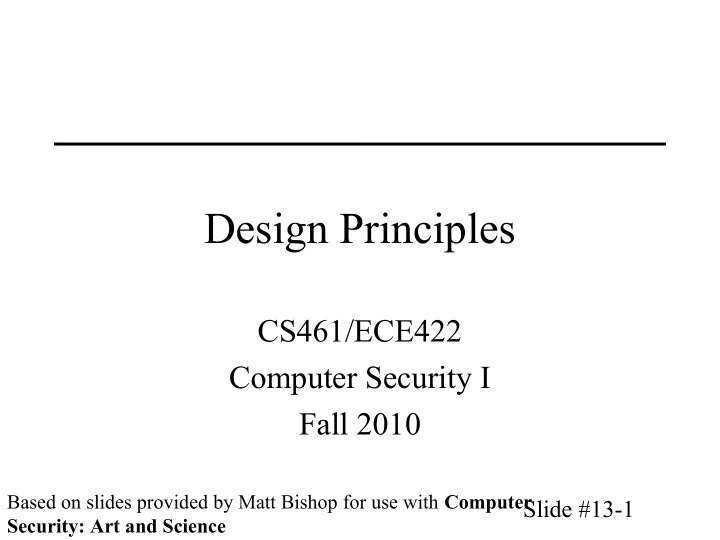

Design Principles CS461/ECE422 Computer Security I Fall 2010 Based on slides provided by Matt Bishop for use with Computer Slide #13-1 Security: Art and Science
Reading Material • Chapter 13 Computer Security: Art and Science Slide #13-2
Overview • Simplicity – Less to go wrong – Fewer possible inconsistencies – Easy to understand • Restriction – Minimize access – Inhibit communication Slide #13-3 Saltzer and Schroeder 75
Summary of Principles • Economy of mechanism • Fail-safe defaults • Complete mediation • Open design • Separation of Privilege • Least Privilege • Least Common Mechanisms • Psychological Acceptability Slide #13-4
Economy of Mechanism • Keep the design as simple and small as possible • Simpler means less can go wrong – And when errors occur, they are easier to understand and fix • Interfaces and interactions Slide #13-5
Fail-Safe Defaults • Base access decisions on permission rather than exclusion • Burden of proof is on the principal seeking permission • If the protection system fails, then legitimate access is denied but illegitimate access is also denied Slide #13-6
Complete Mediation • Every access to every object must be checked for authority • Usually done once, on first action – UNIX: access checked on open, not checked thereafter • If permissions change after, may get unauthorized access • Proposals to gain performance by remembering the result of an authority check should be examined skeptically Slide #13-7
Open Design • The design should not be secret • Do not depend on secrecy of design or implementation – Popularly misunderstood to mean that source code should be public – “Security through obscurity” – Does not apply to information such as passwords or cryptographic keys Slide #13-8
Separation of Privilege • Where feasible, a protection mechanism that requires two keys to unlock it is more robust and flexible than one that allows access to the presenter of only a single key. • Require multiple conditions to grant privilege – Separation of duty – Defense in depth Slide #13-9
Least Privilege • Every program and every user of the system should operate using the least set of privileges necessary to complete the job • A subject should be given only those privileges necessary to complete its task – Function, not identity, controls – Rights added as needed, discarded after use – Minimal protection domain Slide #13-10
Least Common Mechanism • Minimize the amount of mechanism common to more than one user and depended on by all users • Mechanisms should not be shared – Information can flow along shared channels – Covert channels • Isolation – Virtual machines – Sandboxes Slide #13-11
Psychological Acceptability • It is essential that the human interface be designed for ease of use so that users routinely and automatically accept the protection mechanisms correctly • Security mechanisms should not add to difficulty of accessing resource – Hide complexity introduced by security mechanisms – Ease of installation, configuration, use – Human factors critical here Slide #13-12
Examine Scenarios • Paper overhead Slide #13-13
Key Points • Principles of secure design underlie all security-related mechanisms • Require: – Good understanding of goal of mechanism and environment in which it is to be used – Careful analysis and design – Careful implementation Slide #13-14
Recommend
More recommend